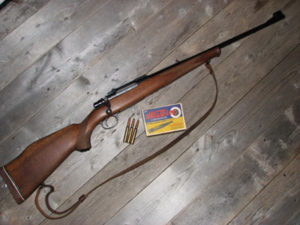Article by
Steve Galea – 02/11/08
Just about every deer hunter I know has a rifle that he or she just won’t part with. It might have been there for an exceptional hunt or memorable trip. Perhaps it was a special gift or the first rifle they ever bought.
I have one like that too – but even though it tugged at my heartstrings, each season, the option of retiring it was looking more and more attractive. Sure it was a well-made, quality rifle, but it had also seen better days.
Luckily, one of my hunting buddies, Brent McPhee of St. Lazare Quebec is a skilled gunsmith. So, when I expressed my thoughts to him, he appraised the old 30.06 and said, “This is a fine rifle; instead of replacing it, why not make the most of it?”
He suggested that we give it a makeover – nothing too serious, just a few modifications that would customize the rifle so that it met my needs and lived up to its true potential. The more I thought about it, the better I liked the idea.
Here’s what we did.
Stock options
The first thing Brent observed was that the rifle’s stock was much too long for me, especially while wearing hunting garb. This, he noted, is a common problem afflicting many hunters. So, he measured and removed approximately two inches of wood and added a new butt plate.
This turned out to be the most important and immediately noticeable modification. Though I had shot several deer with this rifle, it just never felt right when shouldering it and I always had to crane my neck to get the proper eye relief in the scope.
These concerns are no longer an issue. It now fits perfectly when I wear my hunting clothes and this relatively easy fix has gone a long way towards making me shoot that rifle better.
There are a variety of other stock modification options available too. Replacing the old wood with a quality synthetic stock is one practical alternative. So too is simply refinishing the wood to restore its original beauty.
Barrel

Sometimes a minor modification can make the rifle suit the hunting situation better. That’s what we had in mind when we decided to shorten the barrel from 22 to 20 inches.
In my opinion, this, along with the previously mentioned stock modification, balanced the rifle better. It also made it more compact and better suited to the dense hardwoods, rugged hills, thickets, and cedar swamps that I typically hunt in – a place where good shooting opportunities seldom exceed 50 yards.
Shortening the barrel, however, is not without cost. Expect a slight loss of muzzle velocity (in this case approximately 60 feet per second) and a minimal loss in accuracy, the latter mostly because, all things being equal, a heavier and longer barrel (within reason) is easier to hold steady offhand.
In this instance, I deemed these things an acceptable trade-off for a quicker-handling rifle, especially one that still possessed plenty of power and accuracy to do the job at practical hunting distances.
Brent also glass bedded the barrel. In simple terms, this means the barrel was bedded into the stock with liquid epoxy. This process ensures that the barrel is unaffected by the vagaries of moisture, atmospheric pressure, and a hot barrel after repeated shots. Properly done, this procedure allows the barrel to return to the exact same spot shot after shot. This enhances accuracy because the rifle’s point of impact remains consistent despite varying environmental factors. Lastly, Brent re-blued the barrel so that it has a sleek finish that appears out-of-the-box new.
Trigger
Trigger adjustments or even full replacements are another excellent way to improve accuracy, provided it can be done on the firearm in question.
On that old bolt-action, the trigger was overly stiff. So we decided to make it lighter. When all was said and done, Brent had reduced the trigger pull to just over three pounds of pull.
Optics
Of course, all these accuracy-enhancing modifications are to no avail without a good sighting system. In this case, my rifle definitely needed an upgrade; the old 3-9 x 40 scope that I had used for years was, recently, prone to fogging – a curse that cost me one nice buck a couple of seasons ago.
A new model was purchased and mounted. The difference in light gathering, clarity, and quality between the old scope and the new generation high-quality unit is simply remarkable. Needless to say, I don’t except future bucks to be as lucky.
The Right Stuff
We all know that each individual firearm has distinct preferences when it comes to ammunition – but how many of us actually go through the trials to find out what works best? I’m embarrassed to say that though I routinely do this with my .22s and slug guns, I have never been thorough about this with my deer rifle. The sad truth is, I’ve generally used the first box of quality factory ammunition that suited the purpose and was most reasonably priced. And while this has worked fine in the field, I’m also aware I haven’t been getting the best accuracy I could out of my rifle.
This is no longer acceptable to me. I’m now in the process of shooting different brands of ammunition and recording results. By next deer season, I’ll have figured out the best ammunition for that rifle and the deer I take with it – and that’s what I’ll stick with until something better comes along.
Another option I’m seriously considering is hand-loading my own bullets. There’s really no better way of finding a custom load for that special rifle.
Home on the Range
With my deer rifle makeover complete, the only thing left to do is shoot it often and that’s what I’ve been doing. I’ll continue to visit the range regularly in order to learn exactly what my “new” rifle is capable of. I’ll also continue to take it for walks in the woods behind my place, in order to get used to its new feel. If all goes well it’ll be used on wolves, coyotes and groundhogs too. By next deer season, I’ll know its every nuance.
Conclusion
As you might have gathered, customizing an old deer rifle is not an inexpensive proposition – in fact, you could easily buy a brand new rifle for the money spent on this project. On the plus side, not every rifle needs all those modifications. Nor do you have to do it all at once.
Even so, this sort of project isn’t for everyone; some people enjoy buying new rifles and relegating the old ones to an honored place in the gun rack. But if you’re like me – if you take pride in the dents on the stock and the battle scars carried by an old sentimental favorite – then perhaps you’ll consider it money well spent. It took a while, but now I’ve got what is, for all intents and purposes, a new deer rifle that I’m incredibly proud of – and though we have some great memories, I think our future is even brighter.




